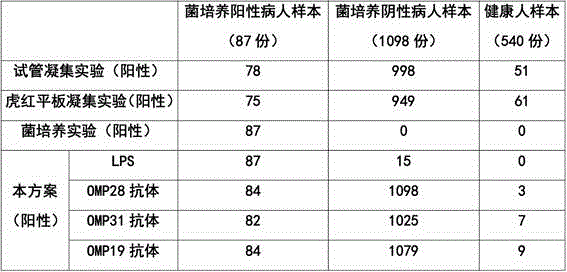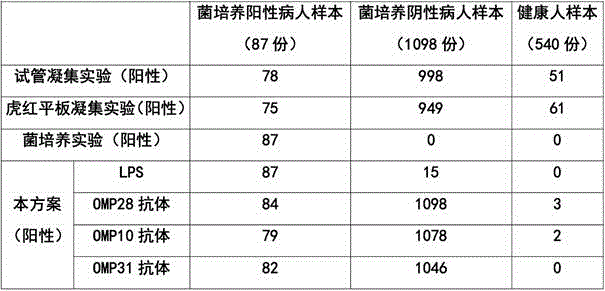Detecting device for Brucella infection
A Brucella and detection device technology, applied in the field of detection devices for rapid detection of Brucella infection, can solve the problems of long detection cycle, poor specificity, strong interference, etc., meet the requirements of lower skill level, and low cost , Reduce the effect of missed diagnosis and misdiagnosis
- Summary
- Abstract
- Description
- Claims
- Application Information
AI Technical Summary
Problems solved by technology
Method used
Image
Examples
Embodiment 1
[0023] 1. Preparation of nanoparticle-labeled detection antibody: Take 1mg of polystyrene fluorescent microspheres with a particle size of 110nm (time-resolved fluorescence, excitation: 360nm, emission: 615nm), wash the particles twice with PBS, and resuspend the particles with 1ml PBS. Add EDC and NHS to make the final concentrations 20mg / ml and 5mg / ml respectively; react at room temperature for 20min; centrifuge, discard the supernatant, and wash the particles twice with PBS; resuspend the particles, add 300μg Brucella lipopolysaccharide monoclonal antibody (C epitope); react at room temperature for 2 hours; add BSA to a final concentration of 1% (W / V), continue to react at room temperature for 2 hours; centrifuge, discard the supernatant, and wash the particles 3 times with PBS; use 10ml reconstitution solution (10mM Tris-HCl (pH8.0), 0.5% BSA) to resuspend the particles and set aside.
[0024] Preparation of nanoparticle-labeled OMP28 protein: take 1mg of polystyrene fluor...
Embodiment 2
[0033] 1. Preparation of nanoparticle-labeled detection antibody: Take 10ml of nano-gold particles with a particle size of 40nm, add 90μg Brucella lipopolysaccharide monoclonal antibody (C epitope); react at room temperature for 15min; add BSA to a final concentration of 1% (W / V), continue to react at room temperature for 15 minutes; centrifuge, resuspend the particles with 1ml reconstituted solution (10mM Tris-HCl (pH8.0), 0.5%BSA), and set aside.
[0034] 2. Preparation of nanoparticle-labeled OMP28 protein: Take 10ml of nano-gold particles with a particle size of 40nm, add 140μg of OMP28 protein (spliced from 1-75AA and 135-225AA, pET-32a plasmid, expressed in E. coli BL21); react at room temperature for 15 minutes; Add BSA to a final concentration of 1% (W / V), and continue to react at room temperature for 15 minutes; centrifuge, and resuspend the particles with 1ml of reconstitution solution (10mM Tris-HCl (pH8.0), 0.5%BSA), and set aside.
[0035] 3. Preparation of chr...
Embodiment 3
[0043] 1. Preparation of nanoparticle-labeled detection antibody: Take 10ml of nano-gold particles with a particle size of 40nm, add 90μg Brucella lipopolysaccharide monoclonal antibody (C epitope); react at room temperature for 15min; add BSA to a final concentration of 1% (W / V), continue to react at room temperature for 15 minutes; centrifuge, resuspend the particles with 1ml reconstitution solution (10mM Tris-HCl (pH8.0), 0.5%BSA), and set aside.
[0044] 2. Preparation of nanoparticle-labeled OMP28 protein: Take 10ml of nano-gold particles with a particle size of 40nm, add 140μg of OMP28 protein (spliced from 1-75AA and 135-225AA, pET-32a vector, expressed in Escherichia coli BL21); react at room temperature for 15 minutes; Add BSA to a final concentration of 1% (W / V), and continue to react at room temperature for 15 minutes; centrifuge, and resuspend the particles with 1ml of reconstitution solution (10mM Tris-HCl (pH8.0), 0.5%BSA), and set aside.
[0045] 3. Preparati...
PUM
| Property | Measurement | Unit |
|---|---|---|
| Particle size | aaaaa | aaaaa |
Abstract
Description
Claims
Application Information
 Login to View More
Login to View More - R&D
- Intellectual Property
- Life Sciences
- Materials
- Tech Scout
- Unparalleled Data Quality
- Higher Quality Content
- 60% Fewer Hallucinations
Browse by: Latest US Patents, China's latest patents, Technical Efficacy Thesaurus, Application Domain, Technology Topic, Popular Technical Reports.
© 2025 PatSnap. All rights reserved.Legal|Privacy policy|Modern Slavery Act Transparency Statement|Sitemap|About US| Contact US: help@patsnap.com



